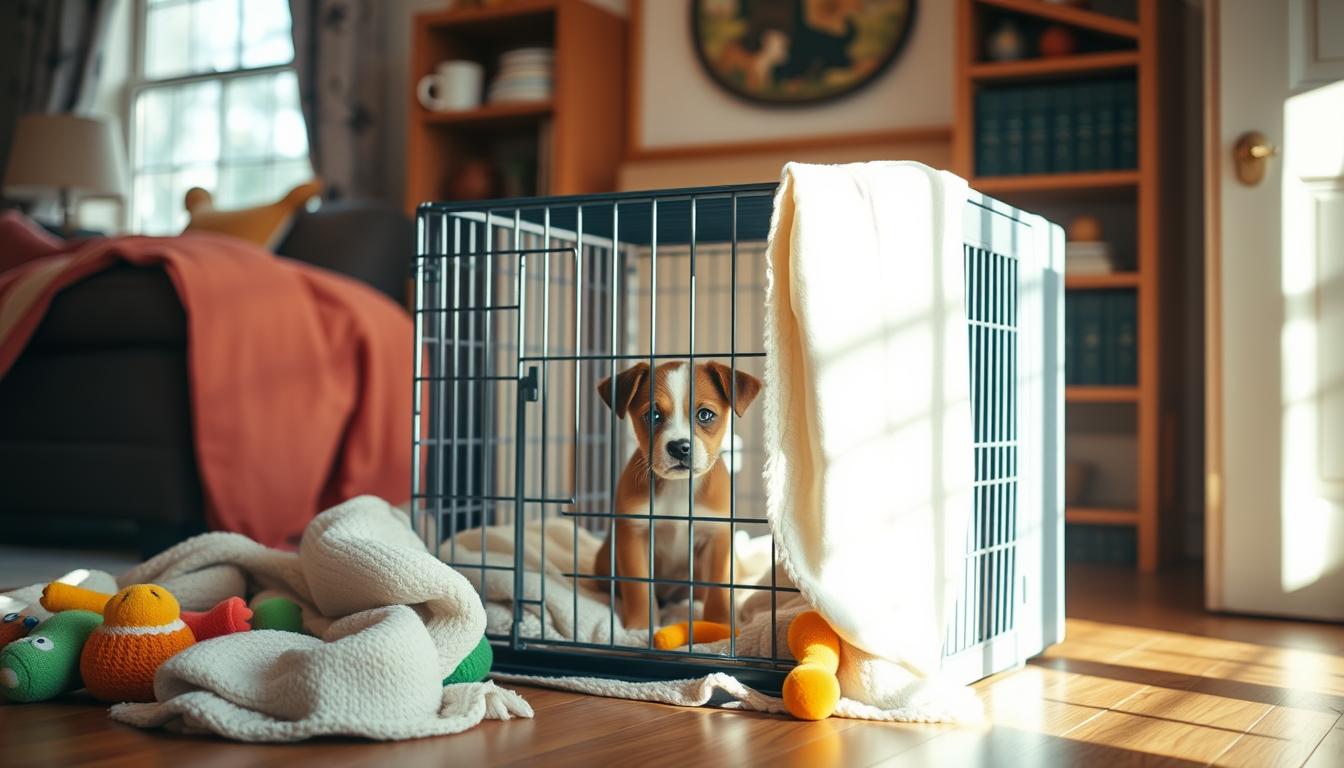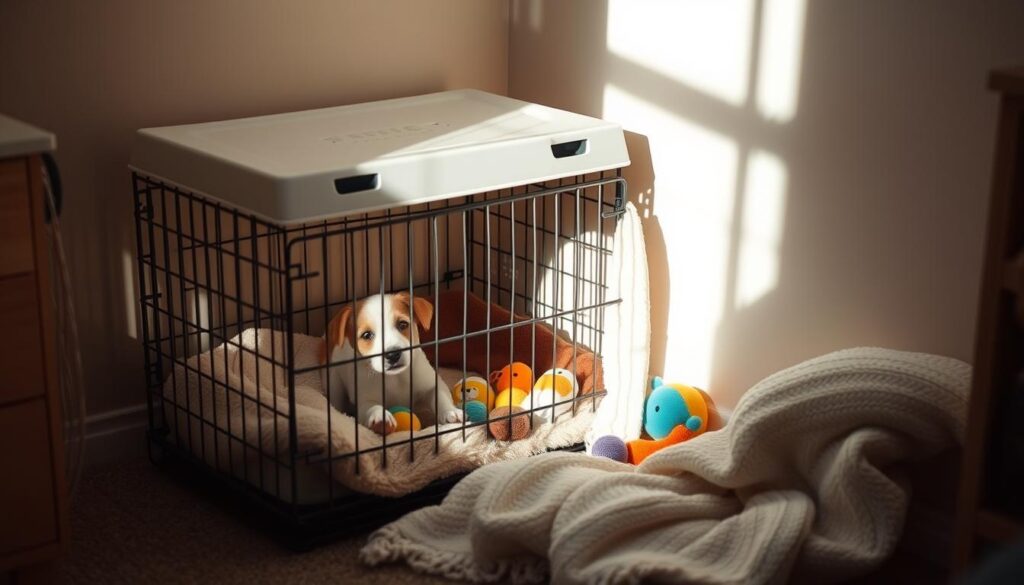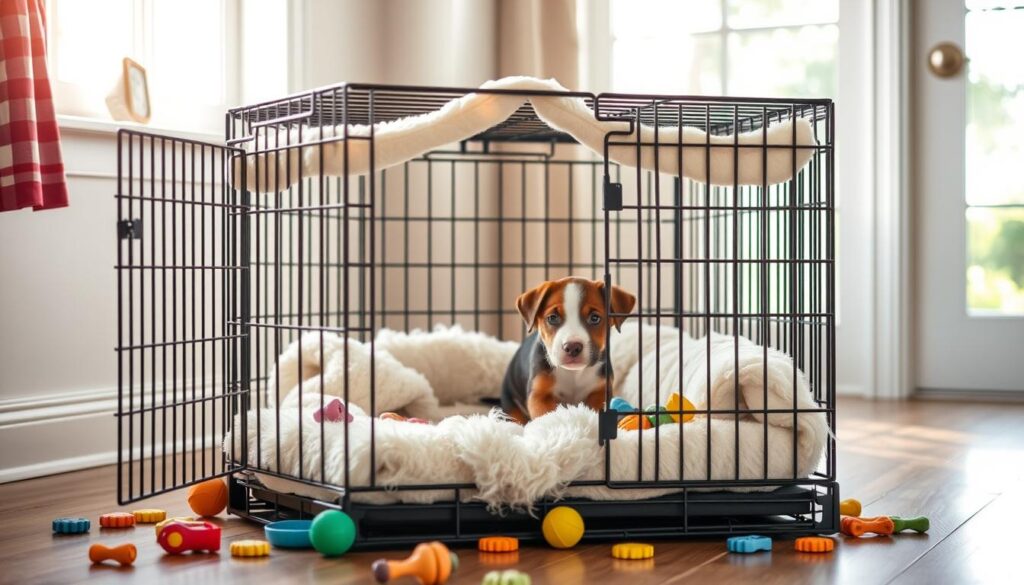Introducing Your Puppy To His/Her New Crate
Published October 4, 2024 Articles

Crate training is a game-changer for housebreaking puppies and giving them a safe spot. But, introducing your puppy to their crate needs careful planning. Start by picking a crate that’s big enough for them to move around and lie down in. It should be just the right size, not too big or too small.
Key Takeaways:
- Crate training is essential for housebreaking and providing a safe space for your puppy.
- Choosing the right crate size is crucial for your puppy’s comfort and well-being.
- Proper introduction and positive reinforcement are key to helping your puppy feel at home in their new crate.
- Taking the time to gradually acclimate your puppy to their crate will pay off in the long run.
- Crate training can help establish a sense of security and routine for your growing pup.
The Importance of Proper Crate Introduction
Crate training is a great way for new puppy owners to keep their pets safe and comfy. It’s all about introducing your puppy to their crate the right way. By making the crate a cozy spot, your puppy will feel safe and happy. This is the first step to a lifelong positive relationship with the crate.
Crate Training as a Housebreaking Tool
Crate training is a smart way to housebreak your puppy. Puppies naturally want to keep their sleeping areas clean. This makes the crate perfect for potty training. It helps them learn to hold their bladder and bowels until you let them out.
This method prevents accidents and teaches your puppy to see the crate as a peaceful place. It’s where they can rest without worry.
Choosing the Right Crate Size
Choosing the right crate size is crucial. It should be big enough for your puppy to stand, turn, and lie down comfortably. But not so big that they use one end for the bathroom and the other for sleeping.
Getting the crate size right helps your puppy feel secure. It makes them see the crate as their own special space, not just a place to be locked up.
By introducing your puppy to their crate the right way, you’re setting them up for success. Crate training not only helps your puppy grow but also strengthens your bond with them.
Creating a Cozy and Comfortable Crate Environment
Getting your puppy used to the crate is a big step. It’s important to make the crate a safe, comfy spot for them. This way, your making puppies comfortable in crates and they’ll see it as a crate as a safe space for puppies.
Rotating Toys and Enrichment
Include a few making the crate comfortable toys for playtime. Change these toys often to keep things interesting and prevent boredom.
Try adding a crate training benefits treat-filled puzzle toy or a crate training schedules for puppies frozen Kong. This will encourage your puppy to enjoy their time in the crate.
 crate as a safe space for puppies pheromone diffuser or calming music. These small steps can make a big difference in transitioning puppy to crate making it a cozy spot for your pet.
crate as a safe space for puppies pheromone diffuser or calming music. These small steps can make a big difference in transitioning puppy to crate making it a cozy spot for your pet.
“A comfortable, familiar crate can be a safe haven for your puppy, providing a sense of security and helping them feel at ease during the training process.”
The aim is to make the crate a positive place for your puppy. By creating a cozy, enriched space, you’ll help your puppy become well-adjusted and confident. They’ll see the crate as their own special area.
Introducing Your Puppy to His/Her New Crate
Establishing Positive Associations
Crate training is key for your puppy’s growth. It’s vital to make it positive. You want your puppy to see the crate as a safe, cozy spot, not a punishment.
Start by putting the crate in a busy area, like the living room or kitchen. Add toys and treats to make it inviting. Puppy crate games like feeding meals or tossing treats inside help too.
Let your puppy get used to the crate by entering and leaving freely. Start with short times and slowly increase it. Be patient, especially with puppy separation anxiety crate, and never force them inside.
Creating a crate as safe space for puppy helps your puppy feel secure. With time and positive feedback, they’ll love their crate. It becomes their own cozy spot.

“The key to successful crate training is to make the crate a positive experience for your puppy, not a place of punishment or confinement.”
Creating a crate training schedule and acclimating puppy to crate is crucial. By introducing and making crate comfortable for puppy properly, you ensure their long-term happiness and safety.
Conclusion
Bringing a new puppy home is thrilling, and introducing them to their crate is key. A slow, positive approach to crate-training makes the crate a safe, cozy spot for your puppy. This helps them feel comfortable and secure.
Start by making the crate a place of good things only. Be patient and consistent. This way, your puppy will learn to go into the crate willingly. It’s a habit that will help both you and your pet in the long run.
Getting your puppy used to their crate early on makes them happy and well-adjusted. With these tips, the first night and the transition to the crate will be easy and stress-free. Enjoy this special time with your new furry friend.
FAQ
What is the importance of properly introducing a puppy to their new crate?
How do I choose the right crate size for my puppy?
How can I make the crate cozy and comfortable for my puppy?
How should I introduce my puppy to the crate for the first time?
How long should I leave my puppy in the crate?
How can I ensure a smooth transition to the crate?
(Article Last Updated on October 5, 2024)
